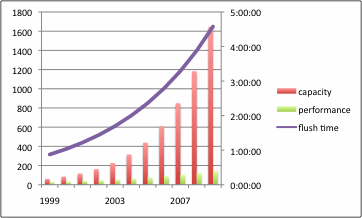Seagate, Western Digital, and others are introducing massive new 3 TB hard disk drives, but will they work with current computers? In order to take advantage of new hard disk drives over 2 TB, you must have a compatible operating system, BIOS, partition table, and file system.
Seagate
Hybrid SSD/Hard Disk Drives: This Time For Sure!
Hard disk drive makers are adding flash storage to their conventional spinning-platter drives to improve performance and are targeting the performance PC market. Wait a second, haven’t we seen this before? As Rocky eventually said to Bullwinkle, “but that trick never works!”
Lemons Into Lemonade: Seagate Repackages SATA As GoFlex
The external hard disk drive market is incredibly hot right now, but it’s also ultra-competitive. The latest trend is dockable multi-function drives that are friendlier to use and offer advanced features like video playback. Most docks rely on USB 2.0, but Seagate just dropped a bomb on the industry with a simple twist: They moved the intelligence outside the case, repackaging the standard internal SATA connector as GoFlex, an external link to a variety of docks and adapters.
Should Home Users Buy Enterprise Hard Disk Drives?
Are “enterprise” drives worth the extra cost in a RAID enclosure? The reason I ask is I’ve had 2 of 4 Seagate ‘consumer’ (7200.12) drives fail in my (Other World Qx2) enclosure. The two drives that failed were maybe a year old, well short of any ‘MBTF’ expectation. Enterprise drives cost nearly twice that of consumer drives.
Flush Time
Single-parity RAID is under attack. Caching is the hottest trend in storage. The end of the high-performance disk drive is imminent. What happened? Increasing areal bit density has caused disk capacity to grow much faster than disk performance. A presentation at Storage Networking World by Ronald Bianchini of Avere exposed the mathematics of this phenomenon.


